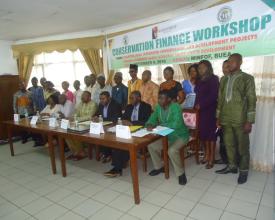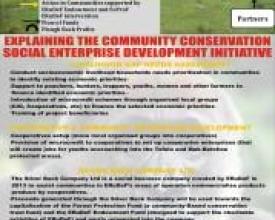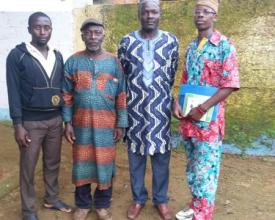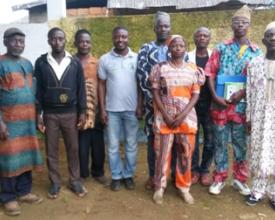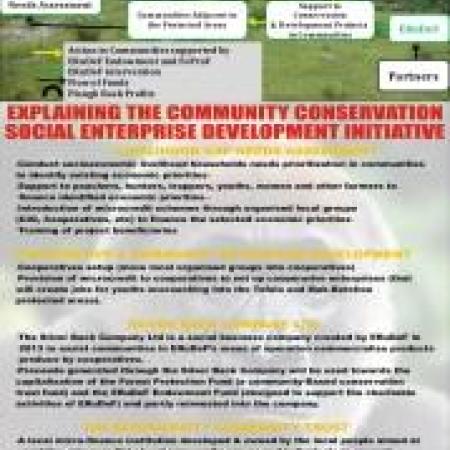
L'initiative CoCoSED (Community Conservation Social Enterprise Development)
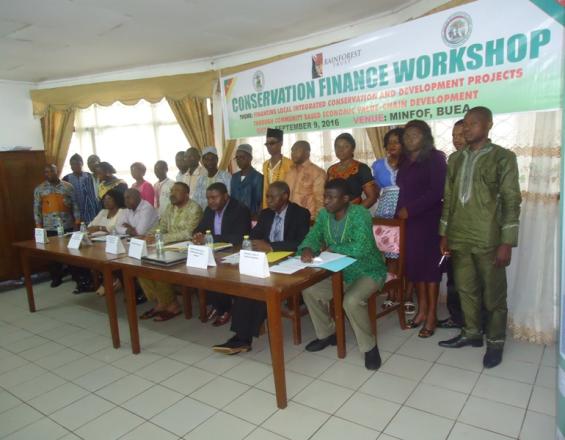
L'initiative Community Conservation Social Enterprise Development (CoCoSED) vise à fournir un financement durable aux activités de conservation tout en offrant une résilience économique et financière à long terme aux communautés voisines des zones protégées, des points chauds de la biodiversité et des paysages fragiles.
Avant la mise en œuvre de cette initiative en 2016, les gorilles recensés étaient au nombre de 25 à 35 individus. Aujourd'hui, ils sont au nombre de 45 et les chimpanzés sont au nombre de 180 à 200. En outre, plus de 1000 membres des communautés adjacentes à la zone protégée ont été formés à la conservation de la biodiversité et d'autres sources de revenus ont été proposées afin d'augmenter les revenus des communautés et de contribuer à la conservation de la biodiversité.
Contexte
Défis à relever
La région des hauts plateaux du Lebialem, où se trouve cette zone protégée, est l'une des régions les plus pauvres du Cameroun. Des revenus très faibles (généralement moins de ½ dollar par jour), des compétences limitées en matière de gestion des terres, l'absence de crédit, le manque d'accès au marché et l'absence de soins médicaux caractérisent toutes les communautés des hauts plateaux, en particulier celles qui bordent l'aire protégée et celles qui sont totalement dépourvues de voies d'accès. Leur économie repose essentiellement sur la chasse, l'agriculture, la cueillette et la pêche. Leur potentiel agricole est faible, d'autant plus qu'ils continuent à cultiver des terres marginales qui subissent des glissements de terrain chaque année et que leurs options économiques sont faibles en raison de l'absence d'accès au marché. Ils dépendent exclusivement de la forêt pour leur subsistance.
Cette initiative vise donc à relever ces défis en offrant à la population locale d'autres sources de revenus durables afin de détourner son attention de la forêt et de préserver la biodiversité. Et d'améliorer encore leurs moyens de subsistance.
Emplacement
Traiter
Résumé du processus
Les blocs sont liés entre eux de la manière suivante : regroupement des différents ménages en coopératives et développement d'entreprises coopératives. L'objectif du regroupement des ménages en coopératives est de s'assurer que tous les produits des ménages sont achetés et commercialisés par le biais du travail de la coopérative. De plus, la coopérative fera des économies par l'intermédiaire du Biodiversity Community Trust et des microcrédits seront également accordés à la coopérative pour mener à bien des activités d'investissement. À ce stade, tous les bénéfices (100 %) reviendront à la coopérative pour être réinvestis. Pour assurer la continuité de la coopérative, ERuDeF, par l'intermédiaire de sa Social Business Division (Silver Back Company Limited), achètera tous les produits de la coopérative à un prix supérieur à celui auquel ils sont achetés, afin que la coopérative puisse réaliser des bénéfices.
En outre, afin de lever des fonds durables pour assurer le développement durable et la conservation de la biodiversité, les bénéfices de la microfinance locale (30 %) et de l'entreprise sociale (60 %) sont versés au Fonds de protection de la forêt. À ce stade, l'argent est utilisé pour mettre en œuvre des initiatives de conservation communautaires telles que l'application de la loi, la lutte contre le braconnage, la surveillance des forêts et les projets d'éco-développement.
Blocs de construction
Développement des coopératives et des entreprises coopératives
L'objectif du regroupement des ménages en coopératives est de s'assurer que tous les produits des ménages sont achetés et commercialisés par le biais du travail de la coopérative. Les membres de la coopérative pourront ainsi vendre leurs produits à un prix plus élevé. De plus, la coopérative fera des économies par l'intermédiaire du Biodiversity Community Trust (BCT) et des microcrédits seront également accordés à la coopérative pour qu'elle puisse réaliser des activités d'investissement. À ce stade, tous les bénéfices (100 %) reviendront à la coopérative pour être réinvestis. Pour assurer la continuité de la coopérative, la Fondation pour l'environnement et le développement rural (ERuDeF), par l'intermédiaire de sa division "Social Business" (Silver Back Company Limited), achètera tous les produits de la coopérative à un prix supérieur au prix de revient, afin que la coopérative puisse réaliser des bénéfices.
Facteurs favorables
Il existe une collaboration entre les membres de la communauté et la Fondation pour l'environnement et le développement rural.
Les membres de la communauté comprennent l'importance de la société coopérative pour le développement économique local.
Renforcement des capacités des membres de la communauté en matière de gestion des coopératives et des entreprises coopératives.
Les membres de la communauté s'engagent à protéger leur environnement.
Leçon apprise
Les leçons apprises sont les suivantes : des fonds supplémentaires sont nécessaires pour intensifier la mise en œuvre, certains membres de la communauté ne collaborent pas suffisamment,
Institution locale de micro-finance
Il s'agit d'une institution locale de microfinance développée et détenue par la population, dont l'objectif est de fournir des microcrédits aux groupes locaux et aux individus afin de soutenir des projets écologiques.
Elle reverse 30 % de ses bénéfices annuels et de ses excédents au Fonds de protection de la forêt pour soutenir des projets de conservation et de bienfaisance.
Facteurs favorables
Les conditions sont les suivantes : formation constante et renforcement des capacités sur l'importance de l'institution de microfinance pour le développement économique, suivi constant pour assurer sa mise en œuvre effective, recrutement de personnes formées dans le domaine de la gestion et du développement de la microfinance.
Leçon apprise
Les défis rencontrés au cours de la mise en œuvre de cette composante sont les suivants ;
Des fonds insuffisants pour intensifier l'éducation des membres, certaines communautés adjacentes à la zone protégée sont résistantes à l'innovation.
Entreprise sociale pour la commercialisation de produits coopératifs
La Silver Back Company Ltd est une entreprise sociale créée par la Fondation pour l'environnement et le développement rural (ERuDeF) en 2013 pour aider les communautés dans les zones d'opération de l'ERuDeF à commercialiser les produits fabriqués par les coopératives.
Les recettes générées par la Silver Back Company seront utilisées pour capitaliser le Forest Protection Fund (un fonds de conservation communautaire) et le ERuDeF Endownment Fund (destiné à soutenir les activités caritatives de l'ERuDeF) et seront en partie réinvesties dans l'entreprise.
Facteurs favorables
Ces facteurs comprennent la disponibilité de produits forestiers non ligneux tels que l'huile de palme, l'éru, le miel naturel et les sous-produits, la disponibilité de sociétés coopératives bien organisées dans la zone protégée et la collaboration des communautés locales.
Leçon apprise
Les leçons tirées sont les suivantes ;
Une nouvelle stratégie doit être mise en place pour améliorer l'efficacité de la mise en œuvre.
La formation et le renforcement des capacités doivent être intensifiés.
De nouveaux produits doivent être identifiés et les chaînes de valeur correspondantes développées.
Les sociétés coopératives doivent être formées et leurs capacités renforcées en matière de production durable de biens.
Le Fonds de protection des forêts
Le Fonds de protection de la forêt (FoProF) est un fonds fiduciaire de conservation communautaire créé pour soutenir les initiatives de conservation des comités de conservation villageois, telles que l'application de la loi, la surveillance de la forêt et les projets d'éco-développement (eau portable, éducation, etc.). Ses fonds proviennent essentiellement du Biodiversity Community Trust (institution locale de micro-finance créée par l'ERuDeF), de dons transmis et des bénéfices de la Silver Back Company (entreprise sociale de commercialisation des produits de la coopérative).
Facteurs favorables
- Mise en place d'un comité de gestion
- Collaboration des membres de la communauté
- Disposition et volonté des gardes forestiers locaux à s'engager dans la surveillance des forêts
Leçon apprise
- Une collaboration constante avec les membres du comité permet d'obtenir de meilleurs résultats
- Davantage de formation et de renforcement des capacités doivent être réalisés afin de renforcer les capacités du comité de gestion dans l'exercice de ses fonctions.
Impacts
Cette initiative a permis d'augmenter le nombre d'espèces menacées telles que les chimpanzés (environ 180-200), les gorilles de Cross-River (entre 25 et 35 en 2016 à environ 45 individus) et certaines espèces de plantes essentielles. En outre, les capacités de plus de 1000 habitants ont été renforcées en ce qui concerne la gestion des zones protégées et l'importance de la conservation de l'environnement.
Sur le plan social, des associations de femmes ont été créées et leurs capacités renforcées dans le cadre d'activités alternatives génératrices de revenus. Des livres ont été donnés aux personnes les plus vulnérables pour faciliter leur éducation. Un soutien au développement d'infrastructures scolaires a été apporté dans cette zone protégée.
Sur le plan économique, plus de soixante-dix jeunes ont été employés dans diverses unités. Le revenu des ménages a augmenté (de moins d'un dollar par jour à 1 USD par jour), quatre industries artisanales ont été créées, les communautés ont pu accéder au marché pour commercialiser leurs produits.
Bénéficiaires
Les principaux bénéficiaires de cette innovation sont les populations les plus vulnérables qui vivent à proximité de la zone protégée. Il s'agit des chasseurs, des trappeurs, des agriculteurs, des ménages pauvres en ressources, des femmes et des jeunes.
Objectifs de développement durable
Histoire

L'ERuDeF, en apportant son soutien aux projets de conservation et de développement dans les communautés adjacentes aux zones protégées par l'intermédiaire de ses partenaires, commence par effectuer une évaluation des besoins en matière de lacunes dans les moyens de subsistance. Il s'agit de connaître le statut socio-économique des personnes vivant à proximité des zones protégées.
Une fois ces statuts connus, l'étape suivante est le développement des moyens de subsistance des ménages. À ce stade, les ménages sont formés à des activités alternatives génératrices de revenus telles que l'apiculture, l'élevage de porcs, etc. Les ménages recevront également des microcrédits par l'intermédiaire du Biodiversity Community Trust (BCT) afin d'améliorer leur investissement et, dans le même temps, ils épargneront en vue d'un investissement futur au sein du BCT. En outre, les bénéfices réalisés au niveau des ménages leur reviendront par le biais de la vente de leurs produits. En outre, les ménages recevront également des dons comme des porcelets de la part de l'ERuDeF. Entre-temps, après un an, le ménage doit rendre le porcelet qui lui a été donné sous la forme d'un cadeau de transmission qui sera ensuite donné au ménage suivant, et le processus continue.
Lorsque le développement des ménages est terminé, l'étape suivante consiste à regrouper les différents ménages en coopératives, tout en développant des entreprises coopératives. L'objectif du regroupement des ménages en coopératives est de s'assurer que tous les produits du ménage sont achetés et commercialisés par le biais du travail de la coopérative. De plus, la coopérative fera des économies par le biais de la BCT et des microcrédits seront également accordés à la coopérative pour qu'elle puisse réaliser des activités d'investissement. À ce stade, tous les bénéfices (100 %) reviendront à la coopérative pour être réinvestis. Pour assurer la continuité de la coopérative, l'ERuDeF, par l'intermédiaire de sa Social Business Division, achètera tous les produits de la coopérative à un prix supérieur à celui auquel ils sont achetés, afin que la coopérative puisse réaliser des bénéfices.
La Silver Back Company Ltd cherchera ensuite un marché pour vendre les produits qu'elle a achetés aux coopératives. À ce stade, 40 % de ses bénéfices seront réinvestis dans l'entreprise, tandis que 60 % iront au fonds de dotation ERuDeF. A ce niveau, 30% du Fonds ira à la gestion de l'aire protégée tandis que les 30% restants iront au Fonds de Protection de la Forêt (FoProF).
Au niveau de la BCT, 30% de son bénéfice annuel ira également au FoProF.
